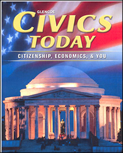Civics Today Citizenship, Economics, & YouChapter 10:
Voting and ElectionsWeb Activity Lesson PlansIntroduction
In this chapter students read about the importance of voting and the many types of elections held in the United States. No matter what level of government, an election campaign takes money. Today millions of dollars are spent on presidential elections. Where does all of that money come from? Are there any limits on how people make contributions to election campaigns? In this activity students will learn about the role of the Federal Elections Commission.
Lesson Description
In this lesson students visit the Web site of the Federal Election Commission. They will read about the history of the FEC and some of the campaign finance laws. After answering several questions, they will write a letter to the editor explaining their own opinion on campaign finance reform.
Instructional Objectives- The learner will be able to describe the history of campaign finance reform.
- The learner will be able to identify the contribution limits of an individual.
- The learner will be able to write an opinion letter.
Student Web Activity Answers- Theodore Roosevelt was the first president to recognize the need for campaign finance reform.
- In 1974 Congress limited contributions by individuals, political parties and PACs and established the FEC.
- The first publicly funded presidential election was held in 1976.
- To a candidate-$2,300 per election.
To a national party committee-$28,500 per year.
To other political action committees-$5,000 per year.
- Students' letters will vary.
 | 




